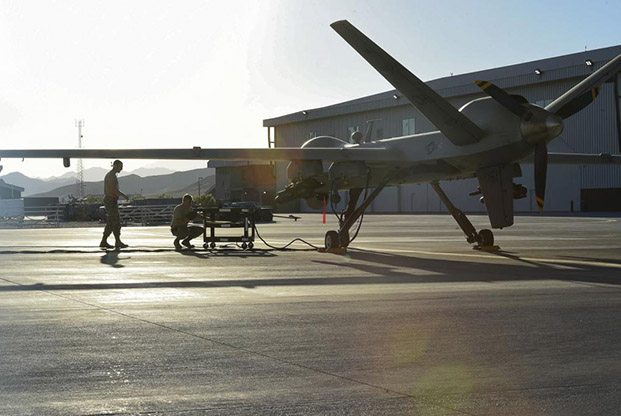
USAF's RPA pilot crews are nearing 100 percent manning, an increase from when the Culture and Process Improvement Plan process began. Air Force photo by A1C James Thompson.
More than two years after finalizing a “get-well” program, the Air Force’s remotely piloted aircraft community still has a long way to go before it can take a break from constant combat and focus on training.
In the meantime, RPA crews are finding other new ways to train, including flying the “vast majority” of their upgrade training missions en route to real-life airstrikes in combat zones, the commander of the Air Force’s main RPA wing said.
Remotely piloted aircraft crews have historically been undermanned and in constant demand, to the point where the Air Force conducted a massive, grassroots review of its community in mid-2015 to determine ways to increase morale and while growing to a more sustainable size. The Culture and Process Improvement Plan included more than 3,300 surveys at 12 bases and included a roadmap to “dwell”—a point where the Air Force can take a squadron off of combat operations to focus on training.
“I think the earliest opportunity we have is the end of 2019 to make that a reality,” said Col. Julian Cheater, commander of the 432nd Wing at Creech AFB, Nev. “That will improve our readiness rate considerably because [then] I can take [aircrews] out of combat to train, … [and] put [them] up against threats that are more representative of near-peer adversaries.”
The Air Force’s RPA pilot crews are nearing 100 percent manning, an increase from when the CPIP process began. However, the enlisted sensor operator career field is much lower, closer to 80 percent, as the Air Force tries to increase its retention of these airmen. Cheater noted that airmen’s families also have a vote as they face regular deployments and long hours at remote bases.
The manning issues come as the Air Force plans to stand up more RPA squadrons — later this month, the service will stand up a new squadron and group at Shaw AFB, N.C. These units will begin flying combat sorties immediately, even before they reach 100 percent manning, because of the unrelenting demand for combat support from MQ-9s and other RPAs.
As of now, the “vast majority” of training for RPA crews happens on “combat lines,” Cheater said. This means that a crew flying over a combat zone en route to a possible airstrike takes the time to fly upgrade training, which usually would happen at home bases over local airspace. If this aircrew is not qualified to conduct an actual airstrike, another pilot will take over to release the weapon, Cheater said.
Reaper missions can last more than 20 hours, and RPA crews work in three different shifts throughout the day to fly, at the most, eight hours. Generally, RPA pilots and sensor operators need to be qualified in two different combatant command theaters but will fly in only one part of the world in one day, Cheater said. “You come in today and fly in this part of the world, tomorrow in this part of the world,” he said. There is typically no switching between the two areas in one day because each theater has different environments, different instructions, and different rules of engagement, he said.
“I really want you to specialize,” Cheater said. “That’s a restriction I place on the squadrons. Be really good at two places.”
Cheater said Creech has created an environment where its airmen can be proactive about safety, and elect to stop flying if a pilot becomes too tired. The decision to no longer fly is between the squadron and the supported combatant command, meaning local commanders are not required to step in to approve.
The RPA ranks are filled with junior officers and enlisted airmen, unlike any other airframe community, Cheater said. For example, half of all RPA pilots are lieutenants and half of the sensor operators are junior airmen. Second lieutenants are conducting airstrikes, first lieutenants have repeated combat deployments.
“Second lieutenants are routinely conducting missions,” Cheater said. “I don’t know of any other airframe where you’ve got second lieutenants routinely conducting airstrikes in combat.”
Despite the operations tempo posing challenges, Cheater said the RPA community also sees this as a positive. Unlike other pilot jobs, RPA pilots are supporting the fight and defending US troops and American interests every day, he said.
Because of the nature of the sorties, RPA crews are very proficient at missions such as close air support, reconnaissance, and time-sensitive targets. However, the crews are less proficient in the types of missions needed for denied environments, mission types Cheater did not want to disclose in public.
“If there’s a near-peer fight, we will be there,” he said. “There’s no doubt in my mind. The question is: Are we going to go day one? Are we going to go before day one? Are we going to go day three?”
